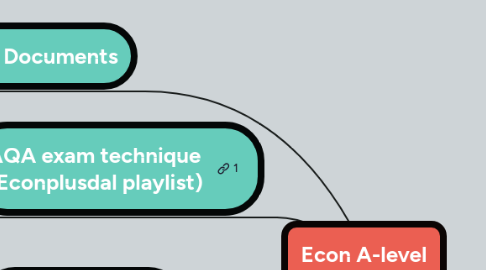
1. Key Documents
1.1. Specification
1.2. Cornell Questions
1.3. Past Papers
1.3.1. AS (Y12)
1.3.1.1. Paper 1 - Micro
1.3.1.2. Paper 2 - Macro
1.3.2. Full A-level (Y13)
1.3.2.1. Paper 1 - Micro
1.3.2.2. Paper 2 - Macro
1.3.2.3. Paper 3 - Synoptic
1.4. Revision Book & Timetables
2. Over and Above
2.1. GENERAL ECONOMICS
2.1.1. Schools of economics
2.1.2. General economics
2.2. UNIT 7 - MARKET STRUCTURES
2.3. UNIT 8 - INEQUALITY
2.4. UNIT 9 - DEVELOPMENT ECONOMICS
2.5. UNIT 10 - BEHAVIOURAL ECONOMICS
2.6. UNIT - 11 - LABOUR MARKETS
2.7. UNIT 12 - INTERNATIONAL ECONOMICS
2.8. UNIT 13 - FINANCIAL ECONOMICS
2.9. Ha Joon Chang essays - "23 Things"
2.10. Shared Drive
2.10.1. https://drive.google.com/drive/folders/1KY0TUxxHEFG-ViMBeMv9Od59Lsw-RZZI?usp=sharing
2.10.2. 1. Copy and paste the link above into your browser
2.10.3. 2. Click the video you want to watch
2.10.4. 3. If the video does not start, and you get a message: "WHOOPS, THERE WAS A PROBLEM PLAYING THIS VIDEO" then go to 4.
2.10.5. 4. Click on the 3 dots in the top right corner of the page and choose "Open in new window"
3. AQA exam technique (Econplusdal playlist)
4. Potential 9-mark diagram questions
5. EZY Econ Revision Slides
6. Units
6.1. Micro
6.1.1. 1. What is economics and what is the basic economic problem?
6.1.1.1. 1. Economics as a social science 2. Economic data 3. The economic problem 4. Production possibility frontiers 5. Specialisation & the division of labour 6. Types of economy 7. Rational decision making
6.1.1.1.1. PowerPoints
6.1.1.1.2. Articles
6.1.1.1.3. Essays
6.1.1.1.4. Videos
6.1.2. 3. How is the price output combination determined in competitive markets?
6.1.2.1. 8. Demand 9.PED 10. XED and YED 11. Supply 12. Price Determination 13. Interrelationships between markets 14. Indirect Taxes and Subsidies
6.1.2.1.1. PowerPoints
6.1.2.1.2. Articles
6.1.2.1.3. Essays
6.1.2.1.4. Videos
6.1.3. 5. Does the market mechanism ever fail?
6.1.3.1. 19. The price mechanism 20. Types of market failure 21. Externalities 22. Information gaps 23. Public and merit goods 24. Government intervention in markets 25. Government failure
6.1.3.1.1. PowerPoints
6.1.3.1.2. Articles
6.1.3.1.3. Essays
6.1.3.1.4. Videos
6.1.4. 7. What is the best way for a market to be structured?
6.1.4.1. 45. Production 46. Costs 47. Revenue 48. Profit 49. Market structure 50. Perfect competition 51. Monopoly 52. Monopolistic competition 53. Oligopoly 54. Contestability 55. Business objectives 56. Efficiency 57. Evaluating competition and monopoly 58. Business growth 59. Technological change
6.1.4.1.1. PowerPoints
6.1.4.1.2. Articles
6.1.4.1.3. Essays
6.1.4.1.4. Videos
6.1.5. 8. Can economics be used to solve poverty and inequality?
6.1.5.1. 68. Equality and equity 69. Redistribution of income and wealth 70. The economic cycle 71. Taxation 72. Government expenditure 73. Unemployment and the Phillips curve 74. Fiscal policy & economic management
6.1.5.1.1. PowerPoints
6.1.5.1.2. Articles
6.1.5.1.3. Essays
6.1.5.1.4. Videos
6.1.6. 10. Does behavioural economics provide a more realistic view of economic behaviour than mainstream economics?
6.1.6.1. 15. Behavioural economics – an alternative view on human nature
6.1.6.1.1. PowerPoints
6.1.6.1.2. Articles
6.1.6.1.3. Essays
6.1.6.1.4. Videos
6.1.7. 11. How does the labour market work?
6.1.7.1. 63. Demand for Labour 64. Supply of Labour 65. Wage Determination 66. Economic Rent 67. Government intervention in labour markets
6.1.7.1.1. PowerPoints
6.1.7.1.2. Articles
6.1.7.1.3. Essays
6.1.7.1.4. Videos
6.2. Macro
6.2.1. 2. How it is the macroeconomy measured and how does it work?
6.2.1.1. 26. National economic performance 27. The circular flow of income 28. National income 29. Consumption and saving 30. Investment 31. Government expenditure and net trade 32. Aggregate demand 33. The multiplier 34. Aggregate supply 35. Equilibrium levels of real national output
6.2.1.1.1. PowerPoints
6.2.1.1.2. Articles
6.2.1.1.3. Essays
6.2.1.1.4. Videos
6.2.2. 4. Is the UK economy performing well?
6.2.2.1. 36. Causes of economic growth 37. The impact of economic growth 38. Inflation 39. Employment and unemployment 40. Balance of payments
6.2.2.1.1. PowerPoints
6.2.2.1.2. Articles
6.2.2.1.3. Essays
6.2.2.1.4. Videos
6.2.3. 6. How can we improve the UK’s macroeconomy?
6.2.3.1. 41. Fiscal policy 42. Monetary policy 43. Supply-side policy 44. Macroeconomic conflicts and trade-offs
6.2.3.1.1. PowerPoints
6.2.3.1.2. Articles
6.2.3.1.3. Essays
6.2.3.1.4. Videos
6.2.4. 9. Can economics be used to make poor countries richer?
6.2.4.1. 90. Measure of Development 91. Factors Influencing Growth and Development 92. Strategies Influencing Growth and Development
6.2.4.1.1. PowerPoints
6.2.4.1.2. Articles
6.2.4.1.3. Essays
6.2.4.1.4. Videos
6.2.5. 12. How does economics work in a global context?
6.2.5.1. 79. Globalisation 80. Specialisation and trade 81. The terms of trade 82. Restrictions on free trade 83. & 84. The EU and trading blocs 85. The WTO 86. Balance of payments issues 87. Exchange rate systems 88. The impact of changes in exchange rates 89. International competitiveness
6.2.5.1.1. PowerPoints
6.2.5.1.2. Articles
6.2.5.1.3. Essays
6.2.5.1.4. Videos
6.2.6. 13. How important is money to economists?
6.2.6.1. 75. Money and the rate of interest 76. Quantity theory of money 77. Financial markets 78. Central banks and financial market regulation
6.2.6.1.1. PowerPoints
6.2.6.1.2. Articles
6.2.6.1.3. Essays
6.2.6.1.4. Videos
